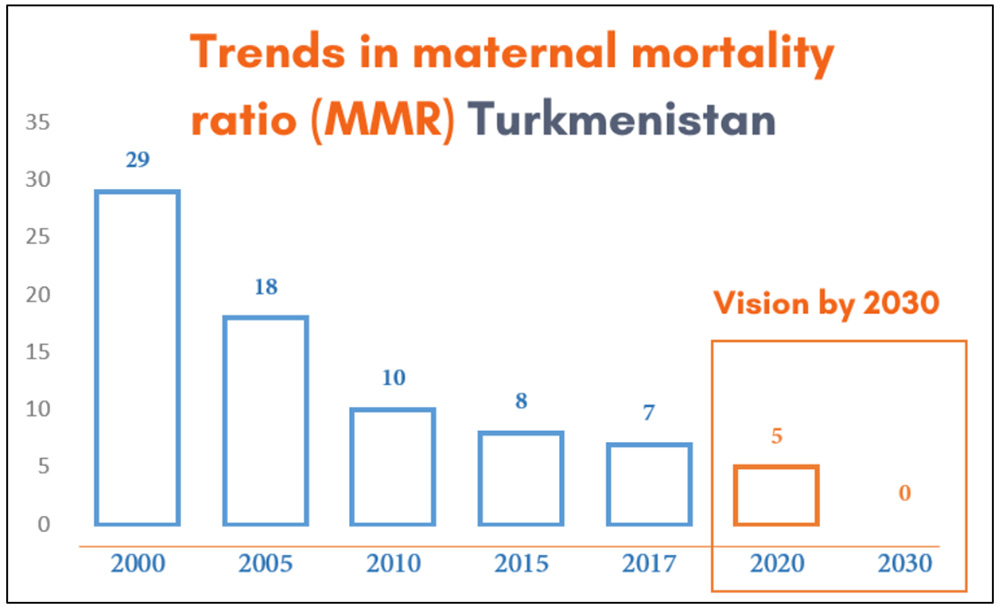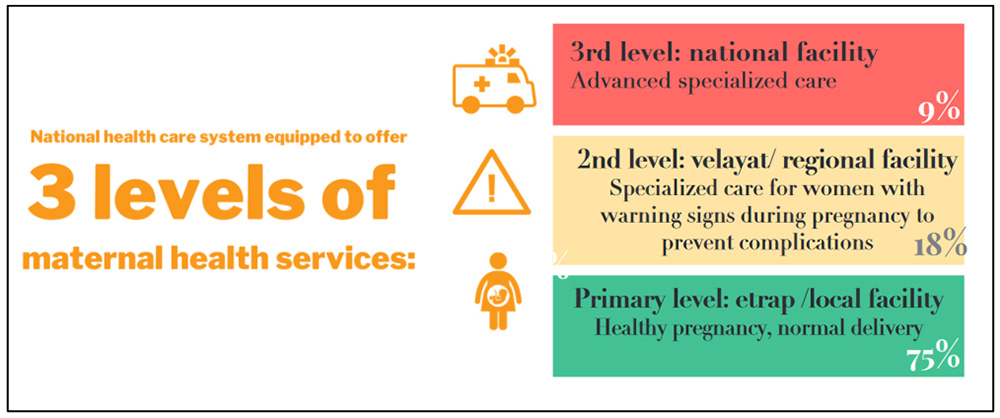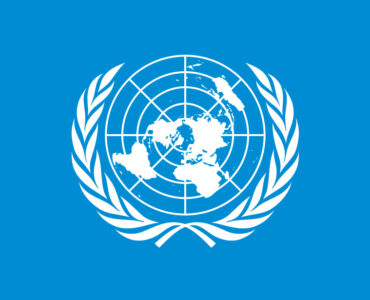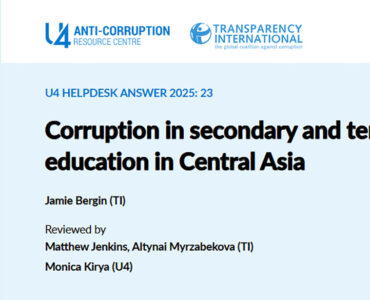Turkmenistan has made some limited headway in reducing maternal mortality but a closer examination of the available data reveals gaps and challenges that could hinder further progress. According to the World Health Organization (WHO), maternal mortality is the death of a woman during pregnancy, childbirth, or within 42 days of the termination of pregnancy – is an important indicator of a woman’s health status in a society. Women should not die from preventable causes related to pregnancy and childbirth.
In their concluding observations on the sixth periodic report of Turkmenistan in February 2024, CEDAW Committee shared their concerns related to maternal mortality, women and girls’ access to sexual and reproductive health services, lack of training of health-care staff on women’s sexual and reproductive health and rights, and lack of publicly available disaggregated data on prevalence of cervical and breast cancer and HIV/AIDS. To reduce maternal mortality, the commitee recommended Turkmenistan to ensure universal access to sexual and reproductive health-care services, to legalize abortion and decriminalize it in all cases and to ensure that women and adolescent girls have adequate access to safe abortion and post-abortion services, to provide free access to modern contraceptives for all women and girls, and to collect data on the prevalence of HIV/AIDS.
In this article we briefly describe the state of maternal health and mortality in Turkmenistan using publicly available information from WHO, UNFPA and the National Statistics Office of Turkmenistan. However, there are inconsistencies in data and the quality of information on maternal mortality in Turkmenistan.
What data is available on maternal mortality?
According to WHO, the maternal mortality rate in Turkmenistan was 29 maternal deaths per 100,000 live births in 2000. By 2020, this rate had dropped to 5 per 100,000, making it one of the lowest in the world. However, the National Statistics Office of Turkmenistan reports a rate of 2.4 per 100,000 in 2020, highlighting a discrepancy between national and international data sources.
Source: UNFPA Turkmenistan.
What has been done to improve maternal health in Turkmenistan?
In 2023 the government of Turkmenistan with the support of the United Nations Population Fund (UNFPA) made limited progress in improving maternal health, which are briefly summarized below.
However, there is no information on whether or how the training materials, content for public education and medical protocols, developed as part of the engagement with the government, have been made available to the public. We were unable to find them online. According to UNFPA:
Donate to support Turkmen analysts, researchers and writers to produce factual, constructive and progressive content in their efforts to educate the public of Turkmenistan.
SUPPORT OUR WORK- Around $700,000 of Government funds were invested in medical diagnostic equipment, emergency obstetric care instruments, medicines, and contraceptives which helped prevent more than 40 potential maternal deaths.
- Basic and emergency obstetric care maternity units are evenly distributed throughout the country and their number meets the WHO standards.
- 44 new obstetrics protocols were implemented in all maternity units. Obstetricians received training on these protocols from regional health experts to ensure consistent maternal care. The training was state-funded.
- Obstetricians in maternity centers throughout the country benefited from analytical tools presented by UNFPA and WHO on conducting the review/self-audit of near miss cases with the purpose of identifying shortcomings and preventing such future cases.
- Women with anemia or chronic diseases receive free contraceptives to prevent unintended pregnancies. As of 2020, 64% of these women were using voluntary family planning services in 95 reproductive health rooms nationwide.
UNFPA has supported the Ministry of Health and Medical Industry of Turkmenistan in setting the three levels of maternal health care, at national, regional and local levels, with a defined set of human resources, equipment, services and standardized clinical practice. As a result, in 2020, 82% of complicated deliveries were handled at regional and national level maternity centers compared to 40% in 2014.
Source: UNFPA Turkmenistan.
What are the main causes of maternal deaths in Turkmenistan?
Women die due to complications during and after pregnancy and childbirth. Most of these complications develop during pregnancy and are preventable or treatable. Other complications may exist before pregnancy but are worsened during pregnancy, especially if not managed as part of the woman’s care. Unfortunately, the Turkmen government does not initiate, develop and fund research studies examining the causes of maternal death in Turkmenistan and the extent to which they are widespread. The major complications that account for nearly 75% of all maternal deaths include:
- severe bleeding after childbirth: According to UNFPA hemorrhage remained as the leading cause of maternal mortality in 2020 while anemia remained prevalent, especially among low-income families. While specific data on the number of cases is limited, the World Bank reports a 28% anemia rate among pregnant women in Turkmenistan in 2019. WHO reports declining doctor-to-population ratio from 27 in 2000 to 21 in 2020. Nevertheless, the 2019 MICS reports that 99.7% of women ages 15-49 years with a live birth in the last 2 years received antenatal care from a medical doctor and 99.8% received assistance during delivery or c-section.
- infections: Sepsis, a life-threatening reaction to an infection, accounts for 8.5% of maternal deaths in the Caucasus and Central Asia region, while HIV related deaths are at 2.3% according to UNICEF. Despite these risks, 70% of Turkmen women lack comprehensive HIV knowledge, and only 58% received HIV counseling during antenatal care. Turkmenistan is also a high-priority country for tuberculosis prevention in the WHO European region.
- high blood pressure during pregnancy: Pre-eclampsia and eclampsia contributed to 14% of maternal deaths in the world in 2014. In Turkmenistan, 1 in 4 women had hypertension or were taking blood pressure medication in 2020. Although 99.9% of women of reproductive age had their blood pressure measured, gave urine and blood samples and had an ultrasound at least once as part of antenatal care in 2019, data on the number of women experiencing hypertension or preeclampsia during pregnancy is lacking in Turkmenistan.
- unsafe abortion: UNFPA funds 95 reproductive health offices in Turkmenistan to provide family planning, contraceptive services, cervical cancer screening, adolescent reproductive health, and safe abortion. It is unclear if and how much funding comes from the government. Nevertheless, nearly 60% of women of reproductive age (15-49) lack control over their reproductive decisions. While women ages 15–19 have been eligible for free access to family planning since 2018, nearly 10% of those who are currently married or in union have unmet needs for family planning. As international organizations estimate, between 2015-2019 83% of unintended pregnancies in Turkmenistan ended in abortion. However, given that the law only allows for abortion until the 5th week of gestation, it might lead to illegal and unsafe abortions.
- insufficient number of trained gynecologists: in 2022, 76 gynecologists were certified in methods to safely terminate pregnancies as needed. However, the total number of providers offering abortion care and their distribution across the country remains unclear. This raises concerns about whether abortion services are accessible in all state medical facilities and if they are available for free, especially considering the estimated annual need for abortions. There is no information about medical abortion being available in Turkmenistan.
- lack of midwives in rural areas: UNFPA Turkmenistan notes a shortage of midwives in rural areas due to low midwifery school enrollment and population growth. This, coupled with limited access and affordability of maternal healthcare for women with disabilities, poses challenges of unknown severity due to lack of data.
Questions to the Ministry of Health and UNFPA in Turkmenistan
While UNFPA reports improvements in maternal mortality, gaps in data on complications, healthcare professionals question Turkmenistan’s low maternal mortality rate claims. Limited public access to this data restricts transparency and accountability, promotes dangerous health practices among population.
Key questions for the government and UNFPA remain unanswered, including:
- What are the key statistics on:
- percentage of women of reproductive age who have access to family planning, broken down by age group, income level, geographic location, and health status?
- the rate of anemia among women, broken down by age group, income level, and urban and rural status?
- the adolescent birth rate according to the government data, broken down by age group, income level, and urban and rural status?
- share of women who receive antenatal care in cities and rural areas?
- total number of skilled birth attendants and obstetric emergency care in cities and rural areas?
- Where can the public and medical professionals learn about and/or access the details of the much mentioned by titles the national programs in the state media:
- the National Strategy on Reproductive, Maternal, Newborn, Child and Adolescent health services for the period 2021-2030 and the budget that was allocated to its implementation
- the results of analytical tools and exercises by UNFPA mentioned on the news secretion on their website?
- credible information in the Turkmen language about contraception on government websites?
- the 44 medical protocols developed in cooperation with UNFPA
- the data from 95 reproductive rooms funded by UNFPA
- the updated guidelines with regards to emergency obstetric care, infection prevention and control developed by the Ministry of Health with the support of UNFPA
- How did the government use the Family Planning Investment Case conducted in 2020 and what are the concrete policies that came out?
- What specific campaigns did the government implement on raising awareness of women and men on contraception measures in urban and rural areas?
UNFPA states that Turkmenistan can end preventable maternal mortality by improving health financing, emergency obstetric care, reproductive health education, contraceptive access, anemia rates, and disease prevention. The Saglyk team emphasizes data collection, transparency and monitoring, and government accountability as crucial prerequisites for effective implementation of these solutions and international programs.








